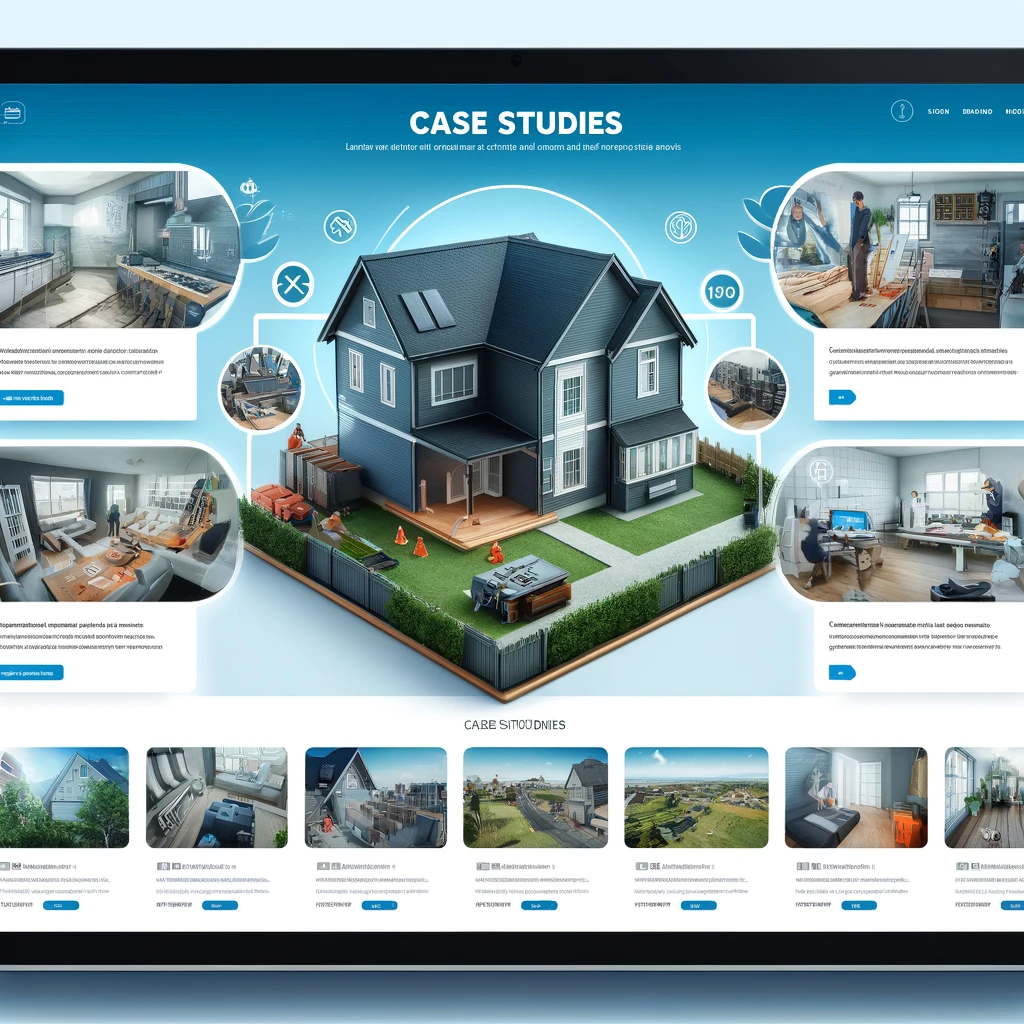Introduction: Elevating Your Roofing Business with a Professional Website

In today’s competitive market, roofing companies in Oklahoma face a unique set of challenges. From intense competition to ever-evolving customer expectations, standing out can feel like an uphill battle. However, there’s a powerful tool that might just be your secret weapon: a professionally designed website.
Imagine this: a potential client is searching online for roofing services. They come across two websites; one is clunky, slow, and looks like it hasn’t been updated since 2005. The other is sleek, fast, and features glowing testimonials and impressive project galleries. Which company do you think they’ll call? The answer is clear—and it demonstrates the impact of first impressions online.
A professional website isn’t just about aesthetics; it’s about functionality, credibility, and ultimately, sales. Jill Konrath, a renowned B2B sales strategist, emphasizes that today’s business buyers are incredibly busy and constantly on the lookout for partners who can improve their own efficiency and effectiveness. A well-designed website communicates that your roofing business is a credible and professional choice, capable of meeting their needs efficiently.
Moreover, blogging expert Heidi Cohen suggests that engaging, relevant content is crucial for keeping potential clients on your page. A blog section with posts on topics like maintenance tips, new roofing technologies, or case studies builds a narrative that not only educates but also connects with your audience on a personal level.
Here’s a simple comparison to illustrate the point:
| Aspect | Old Website | Professional Website |
|---|---|---|
| Speed | Slow | Fast |
| Design | Outdated | Modern and Clean |
| Navigation | Confusing | User-Friendly |
| Content | Sparse | Rich and Engaging |
| Mobile-Friendliness | Poor | Excellent |
Upgrading to a professionally designed website can transform the way potential clients see your business. It’s not just about keeping up with the digital age—it’s about taking charge of your business’s future and setting the stage for increased sales and sustained growth.
The Importance of Professional Web Design

In the realm of roofing businesses, your website serves as the front line of your market presence. It’s often the first interaction potential clients have with your company, and in a digital age dominated by first impressions, the quality of your web design can make or break your business. Let’s explore why a top-tier website is crucial for roofing companies, using insights from Jill Konrath’s B2B sales strategies, Heidi Cohen’s blogging expertise, and best practices from industry leaders like Tecta America.
First Impressions Matter
Jill Konrath emphasizes that in B2B sales, first impressions are pivotal. A potential client’s first visit to your website determines whether they see your business as competent and trustworthy. Tecta America, one of the largest roofing companies in the US, exemplifies this with its professional, sleek web design that not only looks appealing but also communicates reliability and expertise.
Credibility and Professionalism
A professional website enhances your business’s credibility. Clients associate the quality of your website with the quality of your work. A clean, modern design with interactive elements and a seamless user experience shows that you care about quality at every level.
Enhanced User Experience
Heidi Cohen argues that a user-friendly website design is essential for engaging visitors. This means easy navigation, fast loading times, and mobile compatibility—features that Tecta America’s website incorporates effectively. These aspects ensure that once potential clients find your website, they can easily access the information they need without frustration.
Conversion Optimization
A well-designed website is not just about looks; it’s about functionality. Effective Call-to-Actions (CTAs), clear contact information, and persuasive content all contribute to converting visitors into leads. As Jill Konrath suggests, every element on your site should guide potential clients towards making a decision—be it filling out a contact form, signing up for a newsletter, or making a phone call.
SEO and Visibility
Finally, a professionally designed website is optimized for search engines. From the technical structure to the content, every aspect of your site affects how easily potential customers can find you online. Proper SEO practices increase your visibility, particularly in local searches, which is crucial for roofing companies targeting specific regions or communities.
Comparison Table: Basic vs. Professional Website
| Feature | Basic Website | Professional Website |
|---|---|---|
| Design | Outdated | Modern and visually appealing |
| Navigation | Confusing | Intuitive and user-friendly |
| Content | Generic | Customized and engaging |
| SEO | Minimal | Advanced optimization |
| Mobile-Friendliness | Poor | Excellent |
| Loading Speed | Slow | Fast |
Upgrading to a professional website isn’t just an expense—it’s an investment in your business’s future. It strengthens your brand, enhances your market position, and ultimately, drives more sales. Remember, in the competitive world of roofing, a superior website can be the edge you need to stand above the rest.
Key Features of an Effective Roofing Website

When it comes to designing a roofing website that drives sales and enhances customer engagement, certain features are non-negotiable. Drawing on Jill Konrath’s expertise in B2B sales strategies, Heidi Cohen’s blogging insights, and practices from industry leader Tecta America, we can outline the essential components that make a roofing website effective and appealing to both residential and commercial clients.
Responsive Design
In today’s mobile-first world, a responsive website is critical. This means your website automatically adjusts to look great on any device, whether it’s a smartphone, tablet, or desktop. Jill Konrath emphasizes the importance of quick access to information in B2B sales, noting that decision-makers often research options on-the-go. A responsive design ensures that your website is accessible and functional, no matter how your potential clients find you.
Strong Call-to-Actions (CTAs)
A powerful CTA guides your visitors towards taking the next step, whether it’s requesting a quote, scheduling a consultation, or simply contacting your office for more information. Effective CTAs are clear, compelling, and easy to find. They play a crucial role in converting website traffic into genuine business leads.
Portfolio and Testimonials
Showcasing your past projects and customer testimonials builds trust and credibility. Potential clients want to see the quality of your work and hear about others’ positive experiences. Tecta America leverages this on their website by prominently displaying detailed case studies and reviews, reinforcing their reputation as a top roofing provider.
SEO-Optimized Content
Heidi Cohen advises that content should not only be engaging but also optimized for search engines. Your website should include keywords that potential clients are likely to use when searching for roofing services in your area. This increases the chances that your site will appear in search results, driving more organic traffic to your site.
User-Friendly Navigation
A well-organized website with intuitive navigation ensures that visitors can easily find the information they need. This includes a clear menu structure, logical page hierarchies, and informational footers. A frustrating navigation experience can drive potential customers away, while a smooth one can keep them engaged longer.
Feature Comparison Table: What Makes a Roofing Website Stand Out
| Feature | Basic Website | Effective Roofing Website |
|---|---|---|
| Responsive Design | Non-responsive | Fully responsive across all devices |
| CTAs | Hidden or unclear | Prominent and persuasive |
| Portfolio/Testimonials | Limited or none | Extensive and prominently displayed |
| SEO | Minimal optimization | Highly optimized for local and industry-specific keywords |
| Navigation | Confusing | Simple and user-friendly |
By incorporating these key features into your roofing website, you not only enhance its aesthetic appeal but also boost its functionality, making it a powerful tool for attracting and retaining clients. With a focus on professional design and strategic content, your website can act as a cornerstone of your business’s online presence.
How a Great Website Influences B2B Sales

In the B2B sector, the sales process often involves more complexity and longer decision cycles compared to B2C. For roofing companies looking to secure contracts with businesses, property managers, or large scale residential developments, a great website can be a pivotal tool in influencing sales. Let’s break down how a top-notch website impacts B2B sales, drawing from Jill Konrath’s sales strategies, Heidi Cohen’s blogging insights, and practices observed at Tecta America.
Building Credibility and Trust
First and foremost, a professional website establishes credibility. In B2B sales, credibility is crucial because the stakes are often higher and the investments larger. Your website acts as your digital storefront; a well-designed site that looks professional and clearly communicates your capabilities reassures potential clients that you’re a reliable partner. Tecta America’s use of detailed project descriptions and certifications on their website helps establish this trust.
Streamlining the Decision-Making Process
Jill Konrath emphasizes the importance of providing value quickly and effectively in B2B sales. A website with easy navigation, comprehensive service descriptions, and accessible contact information allows potential clients to gather necessary details without unnecessary delays. This streamlined process respects the time of busy professionals and can significantly shorten the sales cycle.
Facilitating Engagements and Conversions
A great website not only attracts visitors but also engages and converts them into leads. This is where effective CTAs come into play. By strategically placing calls to action like “Request a Quote” or “Schedule a Consultation,” you guide potential clients towards taking the next steps. Integrating a blog, as suggested by Heidi Cohen, can also play a role here by providing valuable content that keeps potential clients coming back, increasing the likelihood of conversion over time.
Enhancing Visibility Through SEO
In B2B, where specific niche markets are often targeted, SEO becomes critical. A website optimized for search engines increases your visibility when potential clients search for relevant roofing services. This visibility brings your business to the forefront when corporate decision-makers are conducting preliminary research online.
Demonstrating Capability Through Case Studies
Showcasing successful projects through case studies or a portfolio directly on your website serves as tangible proof of your capabilities and past successes. This is especially important in B2B transactions where past performance is often seen as an indicator of future results. Tecta America excels in this area by highlighting detailed case studies that demonstrate their expertise and results.
Impact of Website Features on B2B Sales Decision Making
| Website Feature | Impact on B2B Sales |
|---|---|
| Professional Design | Enhances credibility and reflects quality. |
| Easy Navigation | Reduces frustration, saves time, and aids decision-making. |
| Effective CTAs | Directly influences lead generation and conversion rates. |
| SEO Optimization | Increases visibility and accessibility in relevant searches. |
| Case Studies | Provides proof of capability and builds trust. |
In summary, a well-designed website is a powerful sales tool in the B2B roofing industry. It not only showcases your company’s professionalism and capability but also streamlines the sales process, enhances engagement, and ultimately drives business growth.
Case Studies: Demonstrating Success in Roofing Projects

Case studies are a cornerstone of effective B2B marketing, particularly in industries like roofing where the proof of capability and quality can significantly influence a business decision. Drawing on the sales strategies of Jill Konrath and the content insights of Heidi Cohen, let’s explore how effectively presenting case studies on your website can enhance your roofing company’s credibility and attract more business contracts.
The Role of Case Studies in B2B Sales
Jill Konrath emphasizes that modern B2B buyers are result-oriented; they need to see evidence that your solutions work before they commit. A well-documented case study not only showcases your past successes but also demonstrates how you’ve addressed challenges similar to those your potential clients might be facing. This relevance makes your pitch more persuasive.
Structure of Effective Case Studies
A compelling case study should be more than just a story. It should be structured to engage potential clients and lead them to see themselves in the narrative. Here’s what it should include:
- Client Background: Briefly describe the client to set the context. This helps website visitors identify with the client.
- Challenge: Detail the specific challenges the client faced that led them to seek your services.
- Solution: Explain how your company addressed these challenges. Highlight the specifics of the approach and any unique methods or technologies used.
- Results: This is the most critical part. Quantify the benefits your client gained from your solution. Use metrics like cost savings, time saved, increase in customer satisfaction, etc.
- Testimonial: If possible, include a quote from the client. This adds a personal touch and boosts credibility.
Example of a Case Study Entry
Let’s illustrate with a hypothetical example based on the type of content you might find on Tecta America’s website:
| Client | XYZ Corporation |
|---|---|
| Challenge | Frequent leaks and insulation problems in corporate buildings, leading to high maintenance costs and energy inefficiency. |
| Solution | Implemented a comprehensive roofing system upgrade with state-of-the-art materials and improved insulation techniques. |
| Results | Reduced maintenance costs by 30%, improved energy efficiency by 20%, and enhanced employee comfort and productivity. |
| Testimonial | “The expertise and professionalism of [Your Company Name] not only solved our immediate roofing problems but also improved our facilities’ overall efficiency.” – John Doe, Facilities Manager |
Using Blogs to Enhance Case Studies
Heidi Cohen suggests that integrating blog content with case studies can deepen engagement. For example, a blog post could detail a particular aspect of the solution provided in a case study, such as innovative roofing materials or techniques used, offering readers more in-depth information and showcasing your company’s thought leadership.
Why Case Studies Matter
Case studies do more than just tell a story; they are a testament to your company’s ability to solve real-world problems. They serve as concrete evidence of your success and are essential for building trust with potential B2B clients. By presenting them clearly and effectively on your website, you provide potential clients with the confidence they need to choose your services.
Integrating Sales and Marketing

In the competitive roofing industry, integrating sales and marketing strategies is crucial for achieving business growth and maintaining a steady flow of B2B contracts. Drawing from Jill Konrath’s B2B sales techniques, Heidi Cohen’s blogging strategies, and best practices from Tecta America, this section explores how roofing companies can synchronize their sales and marketing efforts to maximize results.
Synergy Between Sales and Marketing
The goal of integrating sales and marketing is to ensure that both departments work towards a common objective using aligned strategies. Sales teams excel in understanding customer needs and closing deals, while marketing teams are adept at generating leads and building brand awareness. When these functions are aligned, companies can better target their ideal customers and streamline the buyer journey.
Key Strategies for Integration
- Shared Goals and Metrics
- Establish common objectives for both sales and marketing, such as revenue targets, number of leads, and conversion rates.
- Use shared metrics to evaluate both teams’ performance and encourage collaboration.
- Consistent Messaging
- Develop unified messaging that reflects the brand’s values and selling propositions. This consistency should be evident across all marketing materials and sales pitches.
- Feedback Loops
- Implement regular meetings between sales and marketing to discuss insights, feedback, and adjustments. This helps marketing to tailor content and campaigns based on real sales insights.
- Lead Qualification and Nurturing
- Use marketing efforts to not only generate leads but also qualify them through nurturing campaigns. Sales teams can then focus on leads that are more likely to convert, increasing efficiency.
- Content Strategy
- Utilize Heidi Cohen’s approach by creating content that addresses the entire sales funnel—from awareness and consideration to decision-making. This content should educate potential clients and position your company as a thought leader in the roofing industry.
Practical Example: Tecta America
Tecta America integrates sales and marketing by utilizing a robust online presence that includes an informative blog, SEO-optimized service pages, and active social media engagement. This approach ensures that they attract high-quality leads that are well-informed about their services before they even speak to a sales representative.
Integration Impact Table
| Element | Sales Benefit | Marketing Benefit |
|---|---|---|
| Shared Goals | Clear focus and targeted efforts | Aligned strategies and resource utilization |
| Consistent Messaging | Enhanced pitch effectiveness | Stronger brand identity and customer trust |
| Feedback Loops | Insights for personalized sales approaches | Data-driven content and campaign creation |
| Lead Nurturing | Higher conversion rates | More effective targeting and segmentation |
| Content Strategy | Tools for education and persuasion | Increased engagement and lead generation |
Integrating sales and marketing is not just about sharing goals; it’s about creating a cohesive strategy that leverages the strengths of each team to enhance the overall business performance. For roofing companies, this means delivering the right message to the right audience at the right time, thus driving growth and improving customer satisfaction.
Blog and Content Strategy

A well-executed blog and content strategy is essential for any roofing company looking to engage more deeply with B2B clients and enhance their market position. Drawing on Jill Konrath’s B2B sales insights and Heidi Cohen’s content marketing strategies, this section will explore how a thoughtful blog can attract, engage, and convert your target audience effectively.
Purpose of the Blog in B2B Context
In B2B sales, the decision-making process is typically longer and involves more consideration. A blog serves as a continuous touchpoint between your roofing company and potential clients. It helps to establish your authority in the industry, provides ongoing value to your audience, and keeps your business top of mind when decision times come.
Key Components of a Successful Blog
- Educational Content
- Posts that educate your audience about roofing materials, maintenance tips, and the latest industry trends establish your brand as a knowledgeable and trustworthy source. This type of content also helps in answering common questions, saving your sales team time and establishing a foundational understanding in your prospects.
- Case Studies and Success Stories
- Sharing detailed case studies and success stories in blog format allows potential clients to see the results you have achieved for others. This real-life proof can be persuasive in a B2B setting, showing how your solutions can be applied effectively.
- Industry Insights
- Commentary on industry news and trends not only keeps your content fresh but also shows that your business is up-to-date and involved in the industry at a high level. This can be crucial for maintaining credibility among professional peers and clients.
- SEO-Driven Topics
- Using SEO strategies to guide your topic selection can increase the visibility of your blog posts. Targeting specific keywords related to roofing and your particular services helps attract traffic from search engines, increasing the likelihood of reaching potential B2B clients.
Example Blog Strategy Table
| Type of Content | Objective | Target Audience |
|---|---|---|
| Educational Posts | Educate on best practices and how-to guides | Facilities managers, contractors |
| Case Studies | Showcase success and methodology | Business owners, investors |
| Industry Insights | Provide updates and expert opinions | Industry professionals |
| SEO-Driven Topics | Enhance visibility and attract organic traffic | General online searchers |
Implementing the Strategy
To effectively implement a blog and content strategy:
- Consistency is key: Regular posting keeps your audience engaged and helps with SEO.
- Quality over quantity: Each post should offer real value, reflecting Jill Konrath’s principle of focusing on what truly matters to your clients.
- Engagement through interaction: Encourage readers to comment, share, and interact with your content. This not only improves engagement but also provides valuable feedback and fosters a community around your brand.
Why It Matters
A strategic blog does more than share information; it builds relationships. As Jill Konrath suggests, successful B2B sales are rooted in strong relationships, and a blog is an excellent tool for beginning and nurturing these relationships. By aligning your content with your audience’s needs and integrating it with your broader sales and marketing strategy, you create a powerful resource that drives interest, engagement, and ultimately, sales.
Call to Action: Driving B2B Engagement and Conversion

A well-crafted Call to Action (CTA) is a crucial component of any B2B website, especially for roofing companies aiming to convert online visitors into leads and clients. Jill Konrath’s strategies highlight the importance of clear, compelling CTAs to expedite decision-making, while Heidi Cohen emphasizes the need for CTAs to be contextual and appealing, guiding the user naturally towards taking action. Drawing from the successful practices of Tecta America, this section details how to create effective CTAs that resonate with a B2B audience.
Importance of CTAs in B2B Websites
CTAs serve as the bridge between the interest generated by your website’s content and the action you want the visitor to take, such as requesting a quote, scheduling a service, or downloading a white paper. In the B2B context, where sales cycles are longer and decisions are more calculated, CTAs need to be particularly persuasive and strategically placed to guide potential clients through the sales funnel.
Characteristics of Effective CTAs
- Visibility: CTAs should stand out visually on your webpage, typically through contrasting colors or prominent placement.
- Clarity: The message should be clear and direct, leaving no ambiguity about what will happen when the button is clicked.
- Urgency: Using action-oriented text that conveys a sense of urgency or benefit can motivate users to act promptly.
- Relevance: Tailor CTAs to fit the content on the page and the stage of the buyer’s journey, ensuring they are relevant and appropriate to the viewer’s needs.
Examples of Effective CTAs
Here are some practical CTA examples tailored for different stages of the buyer’s journey:
- Top of the Funnel (Awareness): “Download Our Free Guide to Choosing the Right Roofing Material”
- Middle of the Funnel (Consideration): “Schedule a Free Consultation to Discuss Your Project”
- Bottom of the Funnel (Decision): “Request a Custom Quote Today”
CTA Placement and Strategy
Strategically place CTAs within your website’s design to ensure they are encountered at the right moment in the visitor’s journey. Consider using:
- Homepage: Broad, engaging CTAs that invite users to learn more about your services.
- Blog Posts: Contextual CTAs that suggest downloading additional resources or contacting for more details.
- Service Pages: Direct CTAs that encourage booking a service or requesting a quote.
CTA Impact Table
| CTA Type | Objective | Ideal Placement |
|---|---|---|
| Broad Engagement | To educate and inform | Homepage, About Us page |
| Resource Download | To gather leads through content offers | Blog posts, Resource pages |
| Direct Inquiry | To drive sales or bookings | Service pages, Contact page |
By ensuring your CTAs are clear, visible, and contextually placed, you can significantly improve the user experience on your site and increase the likelihood of converting visitors into clients. Each CTA should be viewed as an opportunity to move relationships forward and drive business growth—a principle that both Jill Konrath and Heidi Cohen advocate in their respective strategies.